Posted by Anita on 08.10.08 8:22 PM
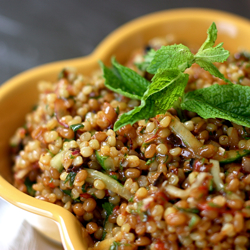 After a whirlwind month of travel, it sure feels good to be home. Even though I was painfully aware of the time we’d spent away from our own kitchen, I hadn’t really grasped how long we’d been absent from the farmers market. Despite our well-planned list, we wandered around the Ferry Plaza in a full-blown daze, like tourists who’d never seen produce before. But our farmers seemed genuinely happy to see us, and the usual summer bounty looked more glorious than ever to our newly appreciative eyes.
After a whirlwind month of travel, it sure feels good to be home. Even though I was painfully aware of the time we’d spent away from our own kitchen, I hadn’t really grasped how long we’d been absent from the farmers market. Despite our well-planned list, we wandered around the Ferry Plaza in a full-blown daze, like tourists who’d never seen produce before. But our farmers seemed genuinely happy to see us, and the usual summer bounty looked more glorious than ever to our newly appreciative eyes.
But somehow — even though we returned home with armloads of the most beautiful food on the planet — our first real meal back home didn’t translate into a fabulous feast. The occasional lackluster supper is bad enough when you’ve put an afternoon of thought and effort into it, but when you’re having company over to boot… ugh.
We turned some of our meat CSA haul into homemade sausage using Ruhlman’s merguez recipe. The test patties we made tasted fine, but an afternoon of fridge-rest made the coils taste blah, not bright. Somehow a Turkish-style soup of tepary beans and cumin — which I’ve made before and loved — turned into a stodgy mess.
For dessert, we harvested three beautiful bergamots off our tree to make champagne-citrus sorbet. But when we cut the fruits open, they were nearly all pith. Desperately squeezing them anyway while praying for a food miracle, we got less than half the juice we needed. We punted and bought a replacement carton from Whole Foods, and served it alongside locally made baklava.
But luckily, despite all the other disappointments, our side dishes turned out pretty well. On the grill alongside the mergez, we roasted skewers of multicolored sweet peppers from Quail Hollow and purple onions from Catalan. And even though it looked a bit like leftover hot cereal, a salad of Full Belly Farms wheatberries — dressed with local vegetables and our own garden herbs — was the best thing we ate all night.
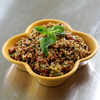
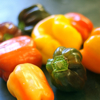
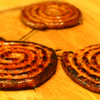
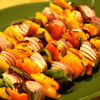

Wheatberry Salad
– adapted from Epicurious
1 cup wheatberries
1 red bell pepper
1/4 cup olive oil
2T fresh lemon juice
1T red-wine vinegar
1 tsp ground cumin
2 cloves garlic, minced
2 tsp coarsely ground aleppo pepper (or to taste)
3T minced parsley
3T mint chiffonade
2 ounces feta, diced small
1/2 cup thinly sliced red onion
1/2 English (or other seedless) cucumber, cut into julienne strips
2T to 1/4 cup chopped brine-cured black olives
 Soak the wheatberries overnight, or for at least a few hours. Cook the berries in a large pot of boiling salted water until tender but not blown out, about 2 hours. (Depending on freshness, wheat variety, and soaking time, this can take as little as an hour or up to 3 hours.) When cooked, drain the berries and set aside.
Soak the wheatberries overnight, or for at least a few hours. Cook the berries in a large pot of boiling salted water until tender but not blown out, about 2 hours. (Depending on freshness, wheat variety, and soaking time, this can take as little as an hour or up to 3 hours.) When cooked, drain the berries and set aside.
Meanwhile, roast the red pepper and place in a brown bag or covered bowl to steam soft, about 20 minutes. When cool enough to handle, remove the skin and seeds, and slice the flesh into long, narrow strips.
In a large bowl, whisk together the olive oil, lemon juice, vinegar, cumin, garlic, aleppo pepper, and salt to taste. Add the cooked wheatberries and stir well to coat; toss in the remaining ingredients. Taste for seasonings and adjust if needed. Serve immediately at room temperature. (You can also refrigerate as needed, but the salad will be stickier. Be sure to remove from the fridge about 30 minutes before serving to take off some of the chill, and toss again to refresh the appearance of the dish.)
entertaining, locavore, One Local Summer, recipes
8 Comments »




Posted by Anita on 08.04.08 8:39 PM
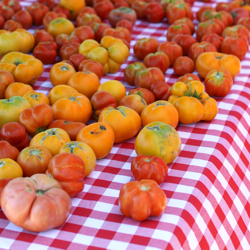 Once upon a time, Southern California was an agrarian epicenter where even small back yards usually boasted a mini-orchard, bursting with citrus or stone fruit.
Once upon a time, Southern California was an agrarian epicenter where even small back yards usually boasted a mini-orchard, bursting with citrus or stone fruit.
My father’s parents lived in semi-rural Monrovia, on a plot that included chickens, a kitchen garden, and a small avocado orchard that Dad tended to earn his allowance. Mom’s parents lived in suburban Glendale, but even their yard was full of edible options, including an enormous orange tree that we harvested for fresh-squeezed juice. As late as the 1980s, there were were actual citrus groves still supplying fruit for roadside stands near my childhood home in Orange.
But these days, urban blight and suburban sprawl have plowed under this once-fertile landscape; the names of streets and boulevards offer the last hint of the area’s pastoral past. Sadly, you’ll find no nuts on Nutwood, no oranges on Orangethorpe, no chiles in Anaheim. A few last pocket farms remain, but by and large they’re limited to mono-crops like strawberries or pumpkins… the kinds of u-pick items that scout troops and school groups will pay to see.
As you might imagine, an area this divorced from its farming heritage makes for a pretty tough locavore life. Despite a few large, well-regarded farmers markets, even the notion of a dedicated farm-to-table restaurant is pretty out on the fringe. LA Weekly–überfoodie Jonathan Gold laments that “the idea of locavore dining is more admired than actually practiced in Los Angeles, even at the restaurants where farmer-celebrities like Alex Weiser or the McGraths are treated with more awe than Matt Damon.”
For home cooks, local produce is widely available so long as your schedule and location make it easy for you to visit the bigger farmers markets in Irvine, Hollywood, or Santa Monica. But if you’re not able to shop on Saturday, you’re pretty much stuck with food of unknown origin. During our recent trip to the area, we rented a vacation house with my family for the week, and so we had access to a kitchen. But we got into town too late to hit the farmers markets… a mistake we will be sure not to repeat!
Much like the supermarkets back home in Northern California, none of those we visited in Los Angeles or Orange County offered any indication of where their food came from. Even Whole Foods was a joke: Items bottled in Napa Valley — at the other end of the state — were proudly labeled as “LOCAL!”. When we asked employees about this, they pointed out Whole Foods’ store policy: Anything raised within 7 hours of the market was considered local… perhaps the most liberal interpretation of locavorism that I can imagine. And although we’re used to having to pay close attention to sourcing even at our local Whole Foods, we were surprised that we didn’t see a single ‘local’ sign in the produce section.
But it was Henry’s Marketplace — part of the Wild Oats chain — that won the hypocrisy prize: A giant banner on the rear wall of the store read: “Choose LOCAL! Enjoy the freshest flavors from your community.” But in fact, the only local products we were able to find in the entire store were Broguiere’s milk (locally processed from semi-local, non-organic herds) and Henry’s own-brand eggs. Not a single fruit or vegetable bin was labeled with its point of origin, much less its farmer’s name.
 After much searching, we stumbled upon the website for South Coast Farms, one of Orange County’s last small-scale farm operations. We took a trek down Coast Highway to find that they do run a daily farm stand with a remarkably diverse set of offerings… our first clue that something wasn’t quite right. Turns out, only a handful of the items for sale are actually grown on site: Tomatoes, cucumbers, onions, and a few herbs. Others are ‘local’ — alas, no indication on signs of farms or even towns — and many are simply big-organic imports from South America. (Apparently, their CSA is a little more focused than the stand.)
After much searching, we stumbled upon the website for South Coast Farms, one of Orange County’s last small-scale farm operations. We took a trek down Coast Highway to find that they do run a daily farm stand with a remarkably diverse set of offerings… our first clue that something wasn’t quite right. Turns out, only a handful of the items for sale are actually grown on site: Tomatoes, cucumbers, onions, and a few herbs. Others are ‘local’ — alas, no indication on signs of farms or even towns — and many are simply big-organic imports from South America. (Apparently, their CSA is a little more focused than the stand.)
Working on a tip that Cal Poly Pomona offered local meat processed by their students, we took a trip out to the Farmstore at Kellogg Ranch. We did find local protein, but frozen chickens and a few sausages were all that the cases held. (Perhaps the stock is better during the school year?) Once again, it was anyone’s guess whether the fruits and veggies on offer were grown locally; there were a number of out-of-season crops for sale that made us suspect not. We got all excited over an entire wall of preserves, pickles, and sauces in quaint Mason jars, until we naively asked the store manager whether they were made by students, or just made from the farm’s own crops. “Oh, no…” she replied, with a tone that implied we’d just rolled off the turnip truck, “We just buy them from a company that puts our label on them.”
Defeated, we stopped into one of the smaller weekday farmers markets to see what we could cobble together. Although there couldn’t have been more than a dozen stalls, the mostly-Latino farmers offered a nice assortment of options: A basketful of tomatillos, a few heads of pungent celery, brown bags of fingerling potatoes, a huge pile of frying chiles, stacks of whiskery onions. Nobody seemed to be indulging in the luxury of specialization, which suited us just fine.
I won’t even go into the afternoon we spent trying to find local rolls for our sausages, but suffice to say we succeeded — even though we bought squishy commercial hoagie buns from the supermarket. A tiny corner store near our beach house supplied us with locally made tortilla chips, which we ate dipped in salsa verde made entirely from farmers market vegetables. For our entrees, we grilled up the German-style bratwurst we’d found at Cal Poly, topped them with a sauteed mix of peppers and onions, and served them on those supermarket buns. On the side, we had our favorite potato salad — everything locally sourced except the mayo and spices… and pickles from one of Kellogg Ranch’s faux-local canning jars.
Of course, it took us all week to get everything we needed, and our carbon footprint was enormous: We took the 100-Mile Diet to a literal extreme, racking up 90+ miles in the car on our search. I’m sure that with a little practice and a lot of hunting, we could find easier sources for much of what we drove around to find. But I’m thankful, more than ever, for the bounty that sits literally at my doorstep in San Francisco.
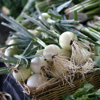

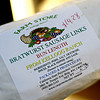

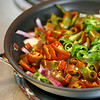
South Coast Farms
32701 Alipaz Street
San Juan Capistrano, CA 92675
(949) 661-9381
Monday through Saturday 9am to 5pm; Sundays 9am to 4pm
The Farmstore at Kellogg Ranch
4102 S. University Drive
Pomona, CA 91768
(909) 869-4906
Sunday through Friday 10am to 6pm; Saturday 8am to 6pm
Tustin Farmers Market
Corner of El Camino Real and 3rd Street
Tuesdays, 9am to 1pm
locavore, One Local Summer, SoCal
16 Comments »




Posted by Anita on 07.31.08 11:02 AM
 We’d planned take a break from Drink of the Week while we’re vacationing down in Southern California with family. (After all, it’s not like we haven’t had plenty to drink lately). But since we already had this recipe planned for our next DOTW installment when Deb at Everyday Food invited us to participate in today’s Cuke & Zuke Fest, how could we resist jumping online to share it with you?
We’d planned take a break from Drink of the Week while we’re vacationing down in Southern California with family. (After all, it’s not like we haven’t had plenty to drink lately). But since we already had this recipe planned for our next DOTW installment when Deb at Everyday Food invited us to participate in today’s Cuke & Zuke Fest, how could we resist jumping online to share it with you?
We had our share of interesting Charlotte Voisey cocktails during the Spirited Dinner at Restaurant August, but her Cucumber and Lavender Sour was our table’s favorite drink by far. It requires a little up-front planning (or shopping), but beyond that it’s simply a straight-up gin sour with a few extra dashes of flavor.
Along with the usual gin botanicals like juniper and coriander, Hendrick’s uses cucumber and rose petals as aromatics in their distillation process, so it’s not surprising that adding cucumbers and floral notes in this drink makes for a delicious end result.
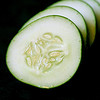


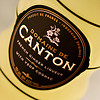

Cucumber and Lavender Sour
– Charlotte Voisey
1-1/2 oz Hendrick’s gin
1/4 oz Domaine de Canton ginger liqueur
3/4 oz lavender syrup (see below)
1/2 oz lemon juice
1/2 egg white
2 slices English cucumber (plus 1 for garnish)
2 dashes lavender bitters*
fresh lavender, for garnish
In a mixing glass, muddle 2 cucumber slices with lavender syrup. Add the remaining ingredients, and shake well with ice. Strain into an ice-filled rocks glass, and garnish with a cucumber slice and sprig of lavender.
Lavender syrup
1/2 cup water
1/2 cup granulated sugar
2T dried lavender flowers
Heat sugar and water together until just dissolved. Remove pan from heat and add lavender. Let sit until cool. Strain out the lavender and filter, if desired. (Alternately, Sonoma Syrup and Monin make commercial versions; the latter has a purple tint.)
* Charlotte uses lavender bitters created by a London friend. If you don’t feel up to concocting your own, Fee Brothers’ grapefruit bitters are a complementary alternative.
Drink of the Week, drinks, other blogs, Tales of the Cocktail
13 Comments »




Posted by Cameron on 07.28.08 10:01 PM
 Sweet spirits of niter, did we get plums this year or what? Last year, our little whip of a tree served up a double dozen of the sweetest, tartest, juiciest globes that we could have ever hoped for. This year, that little whip filled out and buried us under an avalanche of purple fruit.
Sweet spirits of niter, did we get plums this year or what? Last year, our little whip of a tree served up a double dozen of the sweetest, tartest, juiciest globes that we could have ever hoped for. This year, that little whip filled out and buried us under an avalanche of purple fruit.
We saw Plumapalooza coming when we had to prop up one of the tree’s lower branches. The load of ripening plums bent it into a wicked arch, forcing the tip down so far that it touched the ground. However, it’s one thing to gaze admiringly at branchloads of red and purple glory. The reality of harvest is another thing entirely.
Toward the end of June, the very first volunteers hit the ground. Every day, we would gather the fallen and tug gently at likely followers still hanging on the branch. Five a day turned into ten and in a week’s time, we were gathering up between fifteen and twenty plums every morning and every night. By the time it was all over, we figured that we reaped 30-40 pounds of fruit.
Which naturally begged the question of precisely what the hell we were going to do with 40 pounds of plums. Finding a solution seemed especially pressing in the early stages of the deluge as we carefully picked yard bark out of drops and sorted the fruit into piles of Perfect, Not-so-perfect and We-love-you-anyway on the countertop. Ultimately, we knew that we would have to turn to preserves or some other solution that involved canning, but we weren’t ready to go there just yet.
As I stood in the kitchen one weekend, chain-eating plums and staring at the latest load, Anita reminded me that I had talked about making pâte de fruits before the plums started thumping down. Brilliant! Why didn’t I think of that? I checked around and found a few recipes, most of which called for pectin, but Anita sussed out a recipe in the San Francisco Ferry Plaza Farmers Market Cookbook that was nothing but plums, a little lemon juice, and a *lot* of sugar.
My first go at being a candy maker turned out pretty well, but there were some bumps along the road, mostly related to the fact that the recipe instructions about how long to cook the plum/sugar mixture before pouring it into a pan to set didn’t match up with my real-world experience: “Cook over low heat, stirring constantly, until the fruit reduces and thickens and begins to hold together as a mass, 20 to 30 minutes.”
Obvious, right? Easy? Not for this knucklehead. I stood in front of the stove stirring that pot nonstop for THREE FREAKING HOURS while the contents went from a thin purple soup to a bubbling syrup that I — exhausted and convinced that I had made a fatal error somewhere — finally abandoned to the tender mercies of the candy pan.
On behalf of my fellow kitchen idjits, let’s diagnose the sentence that was my nemesis. Cook over a low heat? My friends, it’s probably possible to boil a pot of coffee with a Bic lighter, but it’s going to take a long damn time, and when you’re trying to evaporate a quart or so of liquid, you need something a bit more brisk than low heat. Next time, I’ll be less tender with the flame during the early proceedings.
Second lesson: use a comfortable spoon. For reasons that are now unclear to me, I chose a metal spoon for my stirring utensil (Something to do with not staining the wooden spoons? Maybe? I don’t know. Leave me alone.). All I know is that after several hours of making like the witches in Macbeth, the unforgiving handle had given me a blister.
Last point: I don’t know about you, but when I think of something “holding together as a mass,” I expect to be able to haul out a serious hunk of glop when I raise up the spoon. Au contraire, mon frere. My pot full of plum sweetitude thickened to a syrupy consistency and then stopped. I kept at it, though, stirring away like Jamie Oliver on Quaaludes until I smelled the sugar caramelizing and thought to myself, “Self, if you keep going, you’re going to end up with plum-flavored Jolly Ranchers. If it ain’t done now, it ain’t gonna be done.”
It was done. After setting, cooling, cutting, and dusting with sugar, the final product was chewy, tart, and had the unmistakable twang of sugar that’s had a comfortable and extended acquaintance with the flame. It was good, and the piles of plum candy disappeared more quickly than I would have believed possible, especially when paired in gift bags with Anita’s homemade marshmallows.





Plum Candy
– adapted from the San Francisco Ferry Plaza Farmers Market Cookbook
4 pounds plums, pitted and chopped
2 T water
Juice of 1/2 lemon
About 4 cups sugar
In a large, heavy enameled cast-iron or other nonreactive pot, combine the plums, water, and lemon juice. Place over low heat and cook until the fruit is very soft, about 20 minutes.
Remove from the heat. Puree the plum mixture by forcing it through a fine-mesh sieve or food mill fitted with a fine screen held over a bowl. Measure the puree, return it to the pan, and stir in an equal amount of sugar. Cook over low heat (ha!), stirring constantly (ow!), until the fruit reduces and thickens and begins to hold together as a mass, 20 to 30 minutes (bullshit. see above.).
Line a 9-by-12 inch rimmed baking sheet with parchment (the original recipe says plastic wrap, but I was afraid that it would melt) overlapping the edges. Pour the plum paste onto the lined pan and spread into an even sheet with a rubber spatula. Let cool, cover, and allow to stand at room temperature for 48 hours. The paste will become firm.
Invert the pan onto a cutting board, peel off the parchment, and cut the paste into about 36 small squares. Arrange in layers on waxed paper and store in an airtight plastic container at room temperature.
dessert, garden, locavore, preserving & infusing, recipes
23 Comments »




Posted by Anita on 07.27.08 10:08 PM
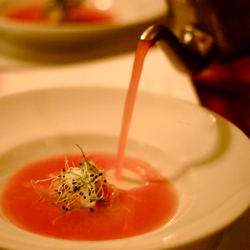 One of the hardest things about traveling is coming home to an empty fridge. Even back when we mostly shopped at the supermarket, this was one of the worst parts of any vacation. But now that we buy nearly all of our food at the farmers’ market, we’ve added a level of complexity to the mix.
One of the hardest things about traveling is coming home to an empty fridge. Even back when we mostly shopped at the supermarket, this was one of the worst parts of any vacation. But now that we buy nearly all of our food at the farmers’ market, we’ve added a level of complexity to the mix.
Luckily, we have a really nice Tuesday lunchtime farmers market at the Ferry Plaza; it’s much smaller than the Saturday showplace, but there’s just enough diversity to re-stock for a few midweek meals, especially if you hit up the indoor shops for meat and bread. So, our 100% local meal this week for One Local Summer included a Range Brothers pork chop dusted in Eatwell rosemary salt, Eduardo’s fusilli with Spring Hill butter, and some Iacopi Farms romano beans… a simple slice of summer.
But honestly, the foods we really wanted to be eating were back in New Orleans, where we spent the last week. Perhaps the feast of the week was our Spirited Dinner at Restaurant August, where chef John Besh created a mostly local, entirely seasonal menu with cocktail pairings by Charlotte Voisey, brand ambassador for Hendricks Gin.
Here’s the menu (and links to photos):
- Chilled melon “soup and salad” local charentais, watermelon, and Vietnamese herbs
- Belle River crawfish agnolotti with Allen Benton’s bacon, Honey Island chanterelles, and sweet fava beans
- Seafood-stuffed breast of local veal Silver Queen corn and crab risotto
- Heirloom tomato tarte tatin with creme fraiche ice cream
It was all quite lovely (well, perhaps excepting the dessert, which was much more interesting in concept than in execution) and it was fun to experience locavore life in another part of the country, where asparagus and favas are still in season, and crayfish — not crab — are fresh and plentiful. But honestly, as delicious as the high-falutin’ food was, it wasn’t very novel. Other than those crayfish, there wasn’t much that couldn’t have made an appearance at a Bay Area restaurant of August’s caliber. No, the true treasures of New Orleans’ local food scene were neither organic or sustainable.
 The Crescent City’s culinary delights are the stuff of legend. Even if you’ve never been to New Orleans, you’ve probably read of the glories of beignets and chicory coffee at Cafe du Monde. I’m sure you’ve heard of Central Grocery‘s legendary muffulettas, and the po-boys at places like Mother’s or Johnny’s. You might even have seen photos of Hansen’s Sno-Bliz, the world’s most perfect frozen delights, the kind of snow cones they might serve in heaven.
The Crescent City’s culinary delights are the stuff of legend. Even if you’ve never been to New Orleans, you’ve probably read of the glories of beignets and chicory coffee at Cafe du Monde. I’m sure you’ve heard of Central Grocery‘s legendary muffulettas, and the po-boys at places like Mother’s or Johnny’s. You might even have seen photos of Hansen’s Sno-Bliz, the world’s most perfect frozen delights, the kind of snow cones they might serve in heaven.
But as lovely as these made-to-order treats are, even the local stuff that comes in bottles and boxes tastes better in N’awlins than whatever it is you have at home. And nobody ever tells you about them! So let me be the first to suggest — nay, insist — that when you visit New Orleans, don’t miss out on some local treasures that can actually make the trip home with you.
Closest to my heart are Zapp’s — a brand of locally made potato chips that taste like a cross between Kettle Chips and manna from heaven. (And I bet you can’t find flavors like Spicy Cajun Craw-Tater, Dill Gator-Tater, or Spicy Creole Tomato back home.) Wash your chips down with a bottle of Abita amber beer, or a Barq’s root beer in the painted-label bottle… both of which taste much better in Louisiana than they do when you happen to run across them elsewhere.
Later, when your appetite comes back, make sure to find a Hubig’s pie or two. The closest analog is those Hostess ‘fruit pies’ you might have eaten as a kid, but they’re so much better that the comparison is entirely inadequate. No high-fructose corn syrup or hydrogenated soybean oil here, just beef fat and pure southern sugar. Their fruit fillings are made from actual fruit and sugar, not chemicals and essences. Tuck one in your carry-on bag for the flight home, and you’ll be the envy of your seat mates for sure.

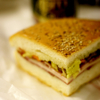
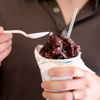
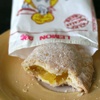

More New Orleans photos and notes on Flickr…
Spirited Dinner: At restaurant August, with cocktail pairings
Central Grocery: Muffulettas, Abita amber, and Zapp’s chps
Cafe du Monde: Beignets and chicory coffee
Mother’s: Ferdi po-boy (ham and ‘debris’)
Johnny’s Po-Boys: Crawfish po’boys, Cajun sausage po’boys, Barq’s root beer
Hansen’s Sno-Bliz: The best snow-cone treats in the cutest little shack
More New Orleans photos: Emeril’s, Tales sessions, Quarter scenery, and more
locavore, New Orleans, One Local Summer, restaurants
6 Comments »




Posted by Anita on 07.18.08 6:36 AM
 Few of our friends can believe that two people as obsessed with food and drink as we are have never been to New Orleans before. But it’s true: This week is our inaugural — although I think it’s safe to say definitely not our last — adventure in the City that Care Forgot.
Few of our friends can believe that two people as obsessed with food and drink as we are have never been to New Orleans before. But it’s true: This week is our inaugural — although I think it’s safe to say definitely not our last — adventure in the City that Care Forgot.
When Cameron mentioned at poker night last week that we were heading to New Orleans, our friend Dave’s eyes lit up. If there’s a San Franciscan who loves NOLA more than Dave, I sure don’t know him. He and his crew of roving debauchés have made their way to the Crescent City at least once a year for the past 11 years.
He sent us a 1,000-word-plus email, jammed with his favorite places and treats, devoting an entire paragraph (after 10 others on more-obscure offerings) just to the touristy French Quarter food & drink experiences that are actually worth the trouble:
“Get a cafe au lait and beignets at Cafe du Monde! Eat a muffaletta from Central Grocery on Decatur Street! Shoot oysters at Acme Oyster House! Get late-night eats and abuse from flaming waiters at Clover Grill! And drink a Pimm’s cup at Napoleon House bar!”
So, never one to pass up good advice, we hopped over to Napoleon House for lunch yesterday. We sat ourselves down amid glorious decrepitude and a century’s worth of graffiti, and ordered up a round of Pimm’s, a half a muffaletta, and a roast-beef po’boy. Ancient ceiling fans rotated overhead as bow-tied waiters shuttled between table, bar, and patio. Mid-meal, our Seattle cadre wandered in from the sidewalk swelter, followed closely by a friend from the other side of the continent. No fools, these drinkers: It was Pimm’s for everyone; tall, cool, and fast.
The Pimm’s Cup is our entry for this month’s Mixology Monday — aptly honoring the fine city of New Orleans, and even more aptly hosted by MxMo’s founder, Paul of Cocktail Chronicles. Now, frankly, I’m not sure how this quintessential English picnic drink became such a New Orleans standard. But if there were a Jeopardy! category called “Drinks of the Big Easy”, it’d be right there in the middle of the board, below the Hurricane, the Ramos Fizz, and the Sazerac, but above the Vieux Carre, the Obituary, and the La Louisiane. No matter the reason for its iconic status, it’s certainly a long, cool refresher that makes a potent antidote to the sticky New Orleans weather, and it’s known as a respectable option for daytime drinking… a pastime in which the Crescent City excels.


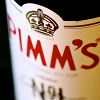


Pimm’s Cup
– Napoleon House, New Orleans
Food & Wine Cocktails 2008
1-1/2 oz Pimm’s No. 1
2-1/2 oz fresh lemon juice
1 oz simple syrup
1-1/2 oz chilled lemon soda (preferably French-style ‘lemonade’, but 7up will do)
cucumber wheel, for garnish
 Add the Pimm’s, lemon juice, and simple syrup to a cocktail shaker. Add ice and shake well, straining into an ice-filled colling glass. Stir in the soda, and garnish with the cucumber wheel.
Add the Pimm’s, lemon juice, and simple syrup to a cocktail shaker. Add ice and shake well, straining into an ice-filled colling glass. Stir in the soda, and garnish with the cucumber wheel.
bar culture, Drink of the Week, Mixology Monday, New Orleans, recipes, Tales of the Cocktail
19 Comments »




Posted by Cameron on 07.17.08 3:29 PM
Married…with dinner is in New Orleans this week for Tales of the Cocktail. This entry is crossposted from Blogging Tales of the Cocktail, where we’re honored to be among the contributors.
Coherent thought is simply too much to ask for after a night of boozing with trained professionals in one of the world’s finest party towns. Even a bag of Zapp’s Cajun Dill Gator-Tators doesn’t seem to be helping to organize my fractured, kaleidoscopic impressions of our first night in Crescent City. And so, expect none from this particular NOLA/Tales virgin.
 After we dropped our bags and grabbed our press credentials on Wednesday night, we headed off to the Palace Cafe. A pair of Beefeaters in full costume greeted us, followed by a bright-eyed nymphette wearing a Union Jack halter and not much else. We slipped into the main party area, and fought through teeming crowds to the bar to grab drinks. Properly fortified, we turned to survey the scene and realized that we had jumped a line 25 people long. Encouraged at getting the week started on the right foot, we pressed on.
After we dropped our bags and grabbed our press credentials on Wednesday night, we headed off to the Palace Cafe. A pair of Beefeaters in full costume greeted us, followed by a bright-eyed nymphette wearing a Union Jack halter and not much else. We slipped into the main party area, and fought through teeming crowds to the bar to grab drinks. Properly fortified, we turned to survey the scene and realized that we had jumped a line 25 people long. Encouraged at getting the week started on the right foot, we pressed on.
The next couple of hours flashed by in a whirl of gin and noise as we put faces to the names of electronic friends—many of them posting here.
 Eventually we were ready for new scenery so we set sail for Arnaud’s, the second destination of the evening. If the Palace was busy, Arnaud’s was packed. We squeezed in like toothpaste going back into the tube and finally found a slightly-less-insane corner toward the rear. Some friends were already here and as more arrived, I began to feel like I hadn’t really gone anywhere. I had joined a roving celebration that flowed from event to event, from place to place, as if the Quarter wasn’t made of separate buildings and bars, but rooms in a single grand mansion.
Eventually we were ready for new scenery so we set sail for Arnaud’s, the second destination of the evening. If the Palace was busy, Arnaud’s was packed. We squeezed in like toothpaste going back into the tube and finally found a slightly-less-insane corner toward the rear. Some friends were already here and as more arrived, I began to feel like I hadn’t really gone anywhere. I had joined a roving celebration that flowed from event to event, from place to place, as if the Quarter wasn’t made of separate buildings and bars, but rooms in a single grand mansion.
 Some started the evening at the Carousel Bar at the Hotel Monteleone. We ended there, twirling around the bartenders and mirrored center column as day one turned into day two.
Some started the evening at the Carousel Bar at the Hotel Monteleone. We ended there, twirling around the bartenders and mirrored center column as day one turned into day two.
bar culture, drinks, New Orleans, other blogs, Tales of the Cocktail, travel
Comments Off on First visit, first Tales




Posted by Anita on 07.16.08 11:39 PM
 I have to say right up front, I never was a big fan of the whole brining craze. I mean, yeah, sure — you pump a turkey or chicken full of salt water, and it stays moist… but the white meat ends up with all the texture of an old sponge.
I have to say right up front, I never was a big fan of the whole brining craze. I mean, yeah, sure — you pump a turkey or chicken full of salt water, and it stays moist… but the white meat ends up with all the texture of an old sponge.
Some pundits (and yes, I’m looking squarely at you, Chris Kimball) prescribe brining as a panacea for nearly every meat, and a few types of seafood, too. But, really, why not start out with a nice piece of meat to begin with and treat it right? After a few squishy suppers, I learned my lesson: Whenever I see “brined” on a menu or in a recipe, I cross it off my list.
But our dinner last week at Nopa got me thinking again. I ordered the justly famous pork chop, and it was everything pork should be, but seldom is: Meaty, juicy, chewy, and flavorful. As I raved to our server, she explained that the delicious Napa-raised pork they use doesn’t need much help. But then she added that a quick 4-hour brine helps boost the flavor so that every bite is seasoned, without turning the texture to wet-paper-towel consistency.
A chop this good is enough to make a brining convert out of even a curmudgeon like me. Determined to repeat the brined chop at home, I turned to the cookbook from the last restaurant where I really remembered being wowed by a pork chop. And wouldn’t you know it: They quick-brine their pork at Boulevard, too. The original recipe calls for making a brine with hot water, then chilling it in the fridge before adding the meat. But I’m lazy and I need to keep moving on the weekends or else nothing gets done. So I cut back on some of the liquid in the dissolving step, and added it back in — in the form of the chicken-stock cubes we keep on hand for sauce-making — to cool the brine in an instant. (If you don’t keep your extra stock in ice cube form, you can always use plain old ice.)
Into the briny deep went a gorgeous Marin Sun Farms chop — a good, thick one we picked up at the farmers market. After its bath and a subsequent drying-out rest in the fridge, we grilled it over medium heat, to avoid scorching the exterior. On the side, we roasted some of Mr. Little’s gorgeous fingerlings in a mix of Spring Hill butter, Sciabica olive oil, our own herbs, and a healthy scattering of gorgeous young Rocambole garlic. We made a pan of Dirty Girl haricot verts using our favorite stovetop method and enjoyed the lot with our pairing this week: Fox Barrel hard cider, the same as we used in the brine.
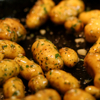
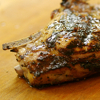


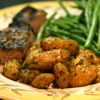
Quick-Brined Pork Chops
– adapted from Boulevard: The Cookbook
1 cup hot water
2T kosher salt
1/4 cup packed brown sugar
1/2 cup hard cider
1T crushed black peppercorns
1T Dijon mustard
5 sprigs thyme
2 tsp chopped fresh rosemary leaves
1/2 cup unsalted chicken stock, frozen (or crushed ice)
2 thick-cut pork chops
Combine the water, salt, and sugar in a large bowl or glass measuring cup, stirring until the salt and sugar dissolve. Add the cider, peppercorns, mustard, thyme, rosemary, and frozen stock. Stir the brine until the stock melts; if still warm, refrigerate until cool.
Put the chops in zip-top bag, and pour the cooled brine over them. Seal the bag, squeezing out as much air as possible. Put the bag in a bowl or glass pan, and arrange or prop up the chops so that they’re standing edgewise. (You want the brine to be in contact with both of the cut sides of the chop. In my small mixing bowl, I can put the chops on their edge and lean them up against the side. If this isn’t possible, just be sure to flip them midway through the brining time.)
 Refrigerate the chops for 1-1/2 hours, or up to 4 hours — no more, or you will have mush. (And if you’re using thinner chops, an hour is plenty!) About 90 minutes before cooking, remove the chops from the brine, and pat dry. place on a plate (or, ideally on a rack over a rimmed baking sheet) in the fridge to dry out the surface a bit, and to allow the brine to equalize throughout the meat. 30 minutes before cooking, bring the chops to room temperature, and preheat your grill or oven. (Heat grill to moderate-high heat, oven to 375°).
Refrigerate the chops for 1-1/2 hours, or up to 4 hours — no more, or you will have mush. (And if you’re using thinner chops, an hour is plenty!) About 90 minutes before cooking, remove the chops from the brine, and pat dry. place on a plate (or, ideally on a rack over a rimmed baking sheet) in the fridge to dry out the surface a bit, and to allow the brine to equalize throughout the meat. 30 minutes before cooking, bring the chops to room temperature, and preheat your grill or oven. (Heat grill to moderate-high heat, oven to 375°).
When chops are at room temperature, season lightly with salt and pepper on both sides. To grill, cook in your usual fashion to medium temperature (140° to 150° before resting time) — timing will vary widely based on the thickness of your chops and the heat of your grill. If cooking in the oven, heat a large, oven-roof skillet over medium heat. (Brining does speed up browning, go a little cooler than you may be used to for searing meat.) When hot, add olive oil just to coat the pan; when hot again, add the chops and cook for 2 to 3 minutes, until golden, Turn the chops over, and move the pan to the preheated oven for 10 to 15 minutes.
When the meat reaches temperature — either on the grill or in the oven — remove from heat and let rest for 5 to 10 minutes. (If you finished in the oven, you can make a simple pan sauce.) Serve with your favorite seasonal accompaniments.
—-
* Edited to add: We removed the link to Cook’s Illustrated in protest of their bullying tactics.
locavore, meat, One Local Summer, recipes
8 Comments »




Posted by Anita on 07.13.08 6:58 PM
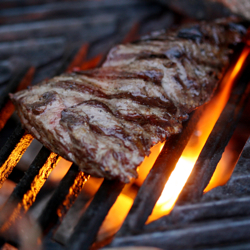 Last week, I went on about how miserably cold and foggy the weather had become. No sooner had I posted than the spell broke, and we traded arctic snap for heatwave. Would a day or two of mild, sunny but breezy weather be too much to ask?
Last week, I went on about how miserably cold and foggy the weather had become. No sooner had I posted than the spell broke, and we traded arctic snap for heatwave. Would a day or two of mild, sunny but breezy weather be too much to ask?
San Francisco proper was mercifully spared the full effects of the heat. But Cameron’s office down south was baking so hard that their air-conditioning conked out… at 9am! And friends of ours in Marin set up a kitchen on the back patio when the mercury passed 105°, making indoor cooking unthinkable. But the City stayed pretty mild, rising only to 85° on the hottest day, and cooling to manageable fan-free levels overnight.
In short, it was the perfect time to break out the grill.
Truthfully, we cook outdoors all year round here, even when the weather is grey. Our grill sits right out the back door of our kitchen, on a second-story deck overlooking the neighborhood and the bay beyond. It’s a pretty idyllic place to cook dinner, sipping a bottle of Speakeasy ale while gazing out at the view. We don’t need a lot of excuses to take our kitchen outside.
 And so last week, we found ourselves enjoying one of our favorite summer meals — carne asada tacos — cooked al fresco over a live fire. Dry-rubbed Marin Sun Farms flank steak, quickly seared and folded into Rancho Gordo tortillas, served with homemade salsas made from some of the best summer produce around. (Tomatillos and chiles are back, sweet onions are abundant, rocambole garlic is making its brief appearance, and cilantro is bolting in the garden like there’s no tomorrow.)
And so last week, we found ourselves enjoying one of our favorite summer meals — carne asada tacos — cooked al fresco over a live fire. Dry-rubbed Marin Sun Farms flank steak, quickly seared and folded into Rancho Gordo tortillas, served with homemade salsas made from some of the best summer produce around. (Tomatillos and chiles are back, sweet onions are abundant, rocambole garlic is making its brief appearance, and cilantro is bolting in the garden like there’s no tomorrow.)
We bought our first ears of corn this week, too — we always put off that purchase until we’re sure we’ll be getting high-season, super-ready ears. To give it a Latin flair, we roasted it on the grill and slathered it in chile-spiked crema, a gringo-style riff on a popular Mexican street snack. Truthfully, I think the creamy spread got in the way of the farm-fresh corn flavor — these ears were so fresh they were wet — but I’ll definitely make it again to help perk up less-than-perfect specimens, when the season’s winding down. It’d be a great way to give supermarket corn a kick, too, I suspect… something we’ll be able to test in a few weeks when we head to a family reunion in the Land of No Local Food.
Oh, and since we had the grill on? We roasted some homemade marshmallows and made semi-local s’mores, with Miette graham crackers and Scharffen Berger chocolate.
Ah yes, this summer is shaping up just fine after all.
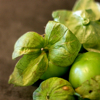



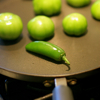
Grilled Corn with Chile Crema
– adapted from Bon Appetit, August 2007
4 T sour cream
1 tsp fresh lime juice
1/2 tsp red chile powder (ancho, chipotle, etc.)
pinch kosher salt
4 ears of corn, unhusked
3T chopped fresh cilantro (optional)
Preheat a gas or charcoal grill to medium heat. Remove outer husks from corn, leaving inner pale green husks attached. Gently fold back inner husks; remove corn silk. Wipe kernels with a tiny bit of oil, then sprinkle with salt and pepper. Rewrap inner husks, and grill corn until husks are charred and kernels are just heated through.
Pull husks back and place corn on a serving platter. Brush corn with spiced crema and sprinkle with cilantro (if desired).
locavore, One Local Summer, recipes
5 Comments »




Posted by Anita on 07.12.08 12:53 PM
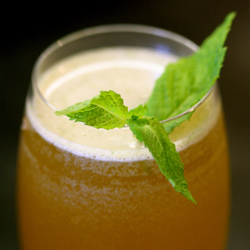 I’ll spare you the history and variations of this particular Audrey Saunders creation for two reasons: (1) We’re doing our best to get ready for next week’s pilgrimage to Tales of the Cocktail and (2) it’s already been covered extensively by everyone from the lowbrow to the highbrow, plus a handful of cocktail bloggers in between.
I’ll spare you the history and variations of this particular Audrey Saunders creation for two reasons: (1) We’re doing our best to get ready for next week’s pilgrimage to Tales of the Cocktail and (2) it’s already been covered extensively by everyone from the lowbrow to the highbrow, plus a handful of cocktail bloggers in between.
But here’s the reason it’s on our radar: Last night, we met up for dinner and drinks with out-of-town guests, Morgan — one-third of the Drink Dogma troika — and his lovely wife Stacey. Our first stop was Nopa, one of our favorite cocktail-savvy restaurants, both because of their fabulous bar program and their delicious (and locavore-friendly) food.
Stacey and I both ordered an Old Cuban to start, but — because I was too busy being social — I didn’t get a chance to take a picture, nor to see how they were putting together this effervescent refresher. Which is a damned shame because now I haven’t the faintest idea how they get this drink to be a rather flamboyant, Shrek-like shade of green.
Even using silver rum (an unorthodox variation, given the Bacardi 8 in the original recipe) I couldn’t achieve anything more than a Mojito-colored khaki. Obviously I need to go back to Nopa and do some more investigation.
Whatever color it is, the Old Cuban makes for a refreshing way to start a warm summer evening at the bar. And if you can talk Morgan and Stacey into joining you, I can guarantee you’ll have a fabulous time.
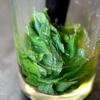

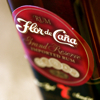
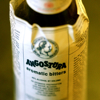


Old Cuban Cocktail
1-1/2 oz aged rum (Bacardi 8 or Flor de Caña 7)
1 ounce simple syrup (or less, to taste)
3/4 oz fresh lime juice
2 dashes Angostura bitters
6 mint leaves
Champagne
Muddle the mint leaves with the simple syrup in a mixing glass. Add the lime juice, rum, bitters, and ice. Shake well. Double-strain (through a Hawthorne strainer and a smaller sieve) into a chilled cocktail glass or flute. Top with bubbly, and garnish with a spring of mint or half a sugared vanilla bean.
bar culture, Drink of the Week, drinks, other blogs
5 Comments »




 After a whirlwind month of travel, it sure feels good to be home. Even though I was painfully aware of the time we’d spent away from our own kitchen, I hadn’t really grasped how long we’d been absent from the farmers market. Despite our well-planned list, we wandered around the Ferry Plaza in a full-blown daze, like tourists who’d never seen produce before. But our farmers seemed genuinely happy to see us, and the usual summer bounty looked more glorious than ever to our newly appreciative eyes.
After a whirlwind month of travel, it sure feels good to be home. Even though I was painfully aware of the time we’d spent away from our own kitchen, I hadn’t really grasped how long we’d been absent from the farmers market. Despite our well-planned list, we wandered around the Ferry Plaza in a full-blown daze, like tourists who’d never seen produce before. But our farmers seemed genuinely happy to see us, and the usual summer bounty looked more glorious than ever to our newly appreciative eyes. Soak the wheatberries overnight, or for at least a few hours. Cook the berries in a large pot of boiling salted water until tender but not blown out, about 2 hours. (Depending on freshness, wheat variety, and soaking time, this can take as little as an hour or up to 3 hours.) When cooked, drain the berries and set aside.
Soak the wheatberries overnight, or for at least a few hours. Cook the berries in a large pot of boiling salted water until tender but not blown out, about 2 hours. (Depending on freshness, wheat variety, and soaking time, this can take as little as an hour or up to 3 hours.) When cooked, drain the berries and set aside.






















































 I’ll spare you the history and variations of this particular Audrey Saunders creation for two reasons: (1) We’re doing our best to get ready for next week’s pilgrimage to
I’ll spare you the history and variations of this particular Audrey Saunders creation for two reasons: (1) We’re doing our best to get ready for next week’s pilgrimage to 





